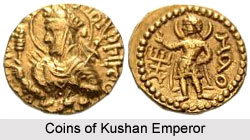 Kujala Kadphises or Kanphises was the first powerful king of the Kushans. He had adopted the title of `wang` or king. His empire extended from river Oxus to river Indus. Bactria, Afghanistan, Eastern portion of Iran and north-west frontier provinces of India were within his empire as well. Some of his coins indicate that he had extended his empire up to Taxila by defeating the last indo Greek king, Harmains. Some of his coins seem to be directly imitated from the coins of his Augustus (27 B.C.-A.D. 14), Tiberius (14-37 A.D.) or Claudius (41-54 A.D.) Kujala Kadphises died at the ripe age of 80 years.
Kujala Kadphises or Kanphises was the first powerful king of the Kushans. He had adopted the title of `wang` or king. His empire extended from river Oxus to river Indus. Bactria, Afghanistan, Eastern portion of Iran and north-west frontier provinces of India were within his empire as well. Some of his coins indicate that he had extended his empire up to Taxila by defeating the last indo Greek king, Harmains. Some of his coins seem to be directly imitated from the coins of his Augustus (27 B.C.-A.D. 14), Tiberius (14-37 A.D.) or Claudius (41-54 A.D.) Kujala Kadphises died at the ripe age of 80 years.
To resolve the difference, which had crept among the different sects of Buddhists and the contradictory principle, Kanishka called the fourth Buddhist council. The reason behind this action was to remove all the misunderstandings. This took place in the Kundalvaa.
Vihara of Kashmir and 500 Buddhist monks took part in it. Vasumitra and Asvaghosha were the president and vice-president to this council. The council discussed the grave and difficult elements of Buddhist texts. The whole proceeding of the council was conducted in the Sanskrit language. The session of the council lasted for six months and several Mahabhasayas on Buddhist texts were written.
The significance of the fourth Buddhist council need not be over emphasized. It gave rise to the Mahayan sect of Buddhism, which became popular in many countries. Regarding the significance of this Buddhist council Rawlinson has remarked as, "Kanishka I`s council at Kashmir marks the beginning of a new epoch in the history of Buddhism. This was the rise of Mahayan or northern churn, which differs as much from the primitive Buddhism of Hinayan or little vehicle of the south, as medieval Catholicism does from the simple creed of the Christians of the first century."



















